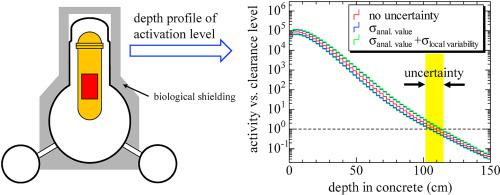当前位置:
X-MOL 学术
›
Prog. Nucl. Energy
›
论文详情
Our official English website, www.x-mol.net, welcomes your
feedback! (Note: you will need to create a separate account there.)
Uncertainty derived from elemental analysis and its effect on the separation of radioactive waste into low-level radioactive waste and waste for clearance
Progress in Nuclear Energy ( IF 3.3 ) Pub Date : 2021-01-01 , DOI: 10.1016/j.pnucene.2020.103597 Norikazu Kinoshita , Takuma Noto , Kazuaki Kosako , Motoyuki Asada , Kazuyuki Torii , Akane Tada , Kohei Urabe , Tsutomu Ohtsuki , Shun Sekimoto
Progress in Nuclear Energy ( IF 3.3 ) Pub Date : 2021-01-01 , DOI: 10.1016/j.pnucene.2020.103597 Norikazu Kinoshita , Takuma Noto , Kazuaki Kosako , Motoyuki Asada , Kazuyuki Torii , Akane Tada , Kohei Urabe , Tsutomu Ohtsuki , Shun Sekimoto

|
Abstract Radioactive cobalt (Co), cesium (Cs), and europium (Eu), produced by neutron-capture reactions of the corresponding trace elements, are the main radioactive components of concrete waste in the decommissioning of aged nuclear power stations. The uncertainty regarding the activity of individual nuclide produced by activation is a main factor for efficient separation of radioactive wastes. Major and trace elements in the geostandard reference JG-3, aggregates collected from quarries, and cements, were analyzed by four different methods to evaluate experimentally the uncertainty. Neutronactivation analysis, a non-destructive technique, and analysis by using instruments such as an inductively coupled plasma mass spectrometry (ICP-MS) following sample digestion by alkali fusion have uncertainties of 30% for the content of major and trace elements. ICP-MS measurements following digestion by HF or K2S2O3 showed a poorer precision, especially for the trace elements. The Monte Carlo simulation using PHITS code was performed to estimate the depth profiles and uncertainty for the radionuclides produced by activation in the concrete including the uncertainty derived from the elemental analyses and local variability. On the basis of the uncertainty, we evaluated the boundary depth between low-level radioactive waste and waste for clearance in a bioshield for the prudent separation.
中文翻译:

元素分析产生的不确定性及其对将放射性废物分为低放废物和清除废物的影响
摘要 放射性钴(Co)、铯(Cs)和铕(Eu)由相应微量元素的中子俘获反应产生,是老旧核电站退役混凝土废物的主要放射性成分。活化产生的单个核素活度的不确定性是有效分离放射性废物的主要因素。地质标准参考 JG-3、采石场收集的骨料和水泥中的主要元素和微量元素通过四种不同的方法进行分析,以通过实验评估不确定性。中子活化分析,一种无损技术,用电感耦合等离子体质谱仪(ICP-MS)等仪器对样品进行碱熔消解后分析,主量元素和微量元素含量的不确定度为 30%。用 HF 或 K2S2O3 消解后的 ICP-MS 测量显示精度较差,尤其是对于痕量元素。使用 PHITS 代码进行蒙特卡罗模拟,以估计混凝土中活化产生的放射性核素的深度剖面和不确定性,包括源自元素分析和局部变异性的不确定性。在不确定性的基础上,我们评估了低放射性废物和生物屏蔽中清除废物之间的边界深度,以进行谨慎的分离。尤其是微量元素。使用 PHITS 代码进行蒙特卡罗模拟,以估计混凝土中活化产生的放射性核素的深度剖面和不确定性,包括源自元素分析和局部变异性的不确定性。在不确定性的基础上,我们评估了低放射性废物和生物屏蔽中清除废物之间的边界深度,以进行谨慎的分离。尤其是微量元素。使用 PHITS 代码进行蒙特卡罗模拟,以估计混凝土中活化产生的放射性核素的深度剖面和不确定性,包括源自元素分析和局部变异性的不确定性。在不确定性的基础上,我们评估了低放射性废物和生物屏蔽中清除废物之间的边界深度,以进行谨慎的分离。
更新日期:2021-01-01
中文翻译:

元素分析产生的不确定性及其对将放射性废物分为低放废物和清除废物的影响
摘要 放射性钴(Co)、铯(Cs)和铕(Eu)由相应微量元素的中子俘获反应产生,是老旧核电站退役混凝土废物的主要放射性成分。活化产生的单个核素活度的不确定性是有效分离放射性废物的主要因素。地质标准参考 JG-3、采石场收集的骨料和水泥中的主要元素和微量元素通过四种不同的方法进行分析,以通过实验评估不确定性。中子活化分析,一种无损技术,用电感耦合等离子体质谱仪(ICP-MS)等仪器对样品进行碱熔消解后分析,主量元素和微量元素含量的不确定度为 30%。用 HF 或 K2S2O3 消解后的 ICP-MS 测量显示精度较差,尤其是对于痕量元素。使用 PHITS 代码进行蒙特卡罗模拟,以估计混凝土中活化产生的放射性核素的深度剖面和不确定性,包括源自元素分析和局部变异性的不确定性。在不确定性的基础上,我们评估了低放射性废物和生物屏蔽中清除废物之间的边界深度,以进行谨慎的分离。尤其是微量元素。使用 PHITS 代码进行蒙特卡罗模拟,以估计混凝土中活化产生的放射性核素的深度剖面和不确定性,包括源自元素分析和局部变异性的不确定性。在不确定性的基础上,我们评估了低放射性废物和生物屏蔽中清除废物之间的边界深度,以进行谨慎的分离。尤其是微量元素。使用 PHITS 代码进行蒙特卡罗模拟,以估计混凝土中活化产生的放射性核素的深度剖面和不确定性,包括源自元素分析和局部变异性的不确定性。在不确定性的基础上,我们评估了低放射性废物和生物屏蔽中清除废物之间的边界深度,以进行谨慎的分离。











































 京公网安备 11010802027423号
京公网安备 11010802027423号